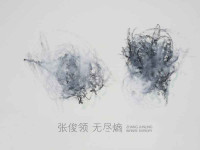
« Back to Exhibitions
Infinite Entropy: Zhang Junling solo exhibition – Curated by Wei Xing
|
Infinite Entropy – chaos, extending, order and growing
The dancer shoots his body up into the air, glides and turns, trying fiercely to cast off the chains of gravity. Floating in the air like a feather – this is the dream of every dancer and all men, the desire to achieve complete freedom one day, gliding gracefully like a gull high above the mountains. However, due to the Law of Universal Gravitation, a law of Classical Mechanics, the dancer falls down on the ground with a slam, throwing up a swirl of dust. Dust particles are sent off into the air, floating like the dancer, leaving spectacular yet invisible curves behind them.
This is all because of Mechanics. Mechanics! Ranging from Celestial Mechanics to Quantum Mechanics and the Second Law of Thermodynamics, Mechanics is simply ubiquitous. And our very existence is the result of various mechanics laws applying on our bodies and physical environment.
Mechanics is inescapable, however, human beings will do everything to resist the law, like flying, like dance, like art. When I look at those fascinating small oil paintings created by artist Zhang Junling, I see hundreds of thousand lines appear to be chaotic, violently tangled and pulsing with every knot, and through them I can see infinite entropy emanating through the canvas in all directions, making the dust look all the more chaotic, turning still from regular curvilinear motions as energy subsides. Surprisingly, the lines in the painting, thick or thin, “grow” gradually from the chaos to a sophisticated, structured mass where energy drifts between the lines and a certain order comes into play. It is a marvelous sight: within a confined space, driven by energy consumption and diffusion, the entropy develops and evolves along two different curvilinear patterns resulting in chaos on the one end and order on the other.
Miraculously presented, the lines are inspired by the perception and expression of each dance movement. The artist wants to intuitively reproduce the relationship between body movements, inner rhythm and the laws of life, casting aside all conceptual constraints. Zhang is based in Heiqiao Beijing and his studio faces a modern dance rehearsal room on the opposite of the street. He often visits the dancers practicing in the rehearsal room where he gets obsessed with the complexity of their body movements and inspired to convey the movement paths. Plainly, it is not the purpose of his works to depict the dancers’ inner feelings or the narrative of dancing. In his creations, the dancers are reduced through abstraction to a medium of energy transmission, deprived of identity and gender. The focus of the paintings is an exploration of body rhythm and rhythmic movements, unconscious perception and reproduction. Additionally, the exploration through visual rendition reveals internal conversion between energy, chaos, order and the Second Law of Thermodynamics.
The Second Law of Thermodynamics dictates that the growth of entropy and its tendency toward chaos are an irreversible process. However, within a given confined space, the growth of entropy does not necessarily lead to chaos or accretion of the dissipative structure. Human behaviors including dancing are, in essence, the conversion of energy into entropy, whereby objects grow increasingly structured and regularized – although assuming the absence of external energy exchange or input, the universe as a whole tends to evolve in a disorder direction, men always seek to break the law of irreversibility in a constant struggle against the laws of nature, resulting in temporary reversibility within a limited time and space. The lines in Zhang Junling’s works appear to be in a state of perpetual motion, keeping alive our hope that we can resist disorder caused by the accretion of entropy through artistic endeavors. As their physical energy dissipates, the dancers’ spirit is resurrected and perpetuated in between the lines, pulsing and dancing, with innumerous instances of energy conversion between an orderly existence and disorder captured in the paintings.
As the dancer landed, his movements slow down and become gentle and delicate. All of his muscles and nerves dilate, stretch and contract – consciously, subconsciously or unconsciously. Energy is building up again waiting for the next explosion. The dancer is poised for another jump, his body is about to rise in the air, turning…at this moment, men successfully break free away the laws of nature, albeit for a limited time, counting as yet another instance of countless counteracts achieved by the human society against the law of entropy within the system of nature and the universe. The artist uses his intuition and brush to capture the locus and passage of such spectacular energy of life. The painted lines – tangled, powerful, agile and lively – resemble rattan and vines growing in the wilderness, creating a structure of order full of internal tension in a world of chaos, following the direction of energy
By Wei Xing
Beijing, July 2015
|
 |

